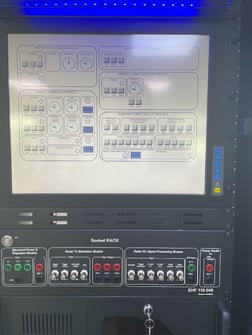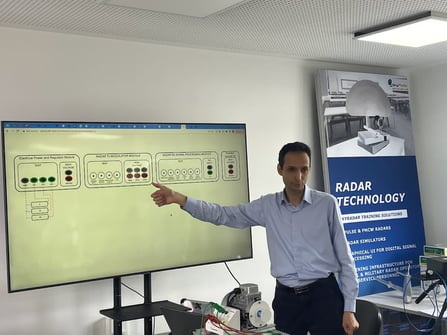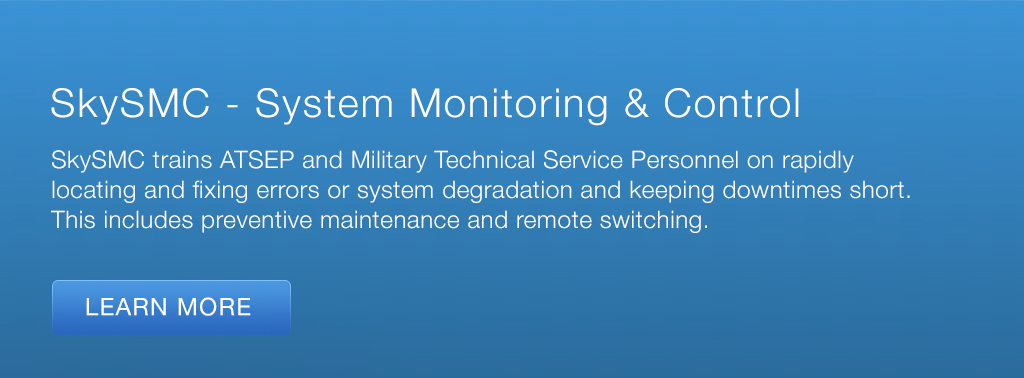Receiver errors due to monopulse accuracy can have significant impacts on air traffic control (ATC) services. Monopulse accuracy is a technique used in radar systems to improve their accuracy in tracking targets. However, transmission errors related to monopulse accuracy can result in errors in the data received by ATC systems, leading to safety risks for aircraft in flight.
Definition of Receiver Errors due to Monopulse Accuracy
Monopulse accuracy is a radar technique used to improve accuracy in tracking targets. It uses multiple beams to measure the angle of the target relative to the radar. Receiver errors due to monopulse accuracy refer to errors that occur in the data received by ATC systems due to inaccuracies in the monopulse radar system. These errors can result in incorrect data being fed into ATC systems, leading to safety risks for aircraft in flight.
What is Monopulse Accuracy?
Monopulse accuracy is a radar technique used to improve the accuracy of radar systems in tracking targets. Traditional radar systems use a single beam to detect the location of a target, but this method is subject to errors due to factors such as atmospheric conditions and reflections from other objects. Monopulse radar systems use multiple beams to detect the angle of the target relative to the radar, which improves accuracy and reduces errors.
For example, in ATC services, monopulse accuracy is used to track the position and altitude of aircraft in flight. By using multiple beams to detect the angle of the aircraft, the system can accurately determine the position and altitude of the aircraft. This information is then used by ATC controllers to guide aircraft safely through airspace.
Scenario Illustrating the Impact of receiver Errors Related to Monopulse Accuracy on ATC Services
Here are two pedagogical scenarios that illustrate the impact of receiver errors related to monopulse accuracy on air traffic control services
Scenario 1: The Misaligned Antenna
In a busy air traffic control center, there is a dedicated controller responsible for monitoring and guiding aircraft through a busy airspace. The controller relies on a sophisticated radar system equipped with a monopulse antenna to accurately track the positions of aircraft.
One day, the controller notices that the positions displayed on the radar screen seem slightly off compared to the actual locations of the aircraft. Perplexed, they investigate further and discover that the receiver of the radar system is experiencing an error related to monopulse accuracy. The misaligned antenna is causing inaccuracies in the azimuth and elevation measurements.
As a result, the controller faces challenges in accurately determining the precise positions of aircraft. This affects their ability to provide precise guidance to pilots and ensure the required separation between aircraft. The misaligned antenna causes delays, increases workload, and introduces potential risks of miscommunication or conflicts due to the compromised monopulse accuracy.
This scenario highlights the importance of a properly calibrated and accurate receiver system in air traffic control services to ensure reliable position tracking and safe management of aircraft movements.
Scenario 2: The Ghost Targets
In a bustling air traffic control center, there is an experienced controller responsible for maintaining a safe and efficient flow of aircraft in a complex airspace. The controller relies on a radar system with a monopulse antenna to detect and track aircraft.
One day, the controller notices the presence of additional targets on the radar display that do not correspond to any actual aircraft. These ghost targets appear intermittently due to a receiver error related to monopulse accuracy. The error causes false signals to be detected and displayed as non-existent aircraft.
The presence of ghost targets creates confusion and hinders the controller's ability to accurately monitor the real aircraft in the airspace. This leads to increased mental workload, potential misinterpretation of the radar display, and compromised situational awareness. It also introduces the risk of issuing incorrect instructions or overlooking genuine aircraft due to the presence of false targets.
This scenario emphasizes the critical need for accurate and reliable receiver systems in air traffic control services, particularly when using monopulse antennas. Receiver errors related to monopulse accuracy can introduce false targets and disrupt the controller's ability to effectively manage air traffic, potentially compromising safety and efficiency.
By presenting these scenarios, learners can grasp the practical implications of receiver errors related to monopulse accuracy on air traffic control services. They can appreciate the importance of precise and well-maintained receiver systems for accurate position tracking and the safe management of aircraft movements.
Impact of receiver Errors Related to Monopulse Accuracy on ATC Services
Receiver errors related to monopulse accuracy can have a significant impact on air traffic control services. Monopulse technology is widely used in radar systems to accurately determine the position of aircraft in the airspace. When receiver errors related to monopulse accuracy occur, it can cause inaccurate position information to be displayed on air traffic control screens, leading to confusion and miscommunication among controllers. This can result in safety hazards and disruptions in the airspace.
Some of the impacts of receiver errors related to monopulse accuracy on air traffic control services are:
Increased Risk of Collision
One of the significant impacts of receiver errors related to monopulse accuracy is the increased risk of collision in the airspace. If the radar system displays inaccurate position information for aircraft, air traffic controllers may not be able to direct the aircraft to a safe distance, leading to a potential collision.
Congestion and Delays
Receiver errors related to monopulse accuracy can cause confusion and miscommunication among air traffic controllers and pilots, leading to congestion and delays in the airspace. Controllers may have to redirect aircraft to other routes or delay their takeoff or landing to prevent a collision.
Reduced Efficiency
Receiver errors related to monopulse accuracy can reduce the efficiency of air traffic control services. If controllers have to spend more time resolving errors and communicating with pilots, it can slow down the entire system and cause delays for all flights in the airspace.
Safety Hazards
Receiver errors related to monopulse accuracy can create safety hazards for aircraft and passengers. If controllers are unable to accurately determine the position of aircraft in the airspace, it can lead to unsafe conditions that can put the lives of passengers and crew at risk.
These impacts highlight the importance of having accurate and reliable radar systems equipped with monopulse technology and the need for regular maintenance and testing to ensure their accuracy. In case of receiver errors related to monopulse accuracy, it's essential to have contingency plans in place to prevent safety hazards and disruptions in the airspace.
Steps to be Taken by ATSEP in Rectification of Receiver Errors Related to Monopulse Accuracy in Detail
ATSEP (Air Traffic Safety Electronics Personnel) are responsible for maintaining and repairing ATC systems, including those that use monopulse accuracy. In order to rectify receiver errors related to monopulse accuracy, the following steps should be taken
Identify the source of the error
The first step in rectifying receiver errors is to identify the source of the error. This can be done through a series of tests and checks on the radar system.
Repair the error
Once the source of the error has been identified, the ATSEP can begin repairing the system. This may involve replacing faulty components or recalibrating the radar system to ensure it is operating correctly.
Test the system
After repairs have been made, the ATSEP should test the system to ensure that the error has been corrected. This can involve running a series of tests and checks to ensure that the system is operating within acceptable parameters.
Monitor the system
It is important to continue monitoring the system after repairs have been made to ensure that the error does not recur. This can involve ongoing maintenance and regular checks on the system to ensure that it is operating correctly.
Steps to be Followed by ATSEP for Preventing Monopulse Accuracy
In addition to rectifying receiver errors related to monopulse accuracy, ATSEP can also take steps to prevent these errors from occurring in the first place. The following steps can be taken to prevent monopulse accuracy-related receiver errors:
Regular maintenance
Regular maintenance of radar systems is essential to ensure that they are operating correctly. This can involve checking for any faults or issues with the system and making any necessary repairs or replacements.
Calibration
Regular calibration of radar systems is also important to ensure that they are operating within acceptable parameters. This can involve adjusting the system to account for any changes in atmospheric conditions or other factors that may affect accuracy.
Training
ATSEP should receive regular training on how to maintain and repair monopulse radar systems. This can ensure that they are up-to-date with the latest techniques and technologies, and can effectively troubleshoot any issues that arise.
Upgrades
Upgrading to newer monopulse radar systems can also help to prevent errors related to accuracy. Newer systems may be more reliable and accurate, and may also incorporate new technologies that improve performance and reduce errors.
Factors Responsible for Monopulse Accuracy-related Receiver Errors
There are several factors that can contribute to monopulse accuracy-related receiver errors. Some of the most common factors include
Atmospheric conditions
Atmospheric conditions such as rain, fog, and wind can affect the accuracy of monopulse radar systems. These conditions can cause interference or reflections that can lead to errors in the data received by ATC systems.
Electronic interference
Electronic interference from other devices or systems can also affect the accuracy of monopulse radar systems. This can include interference from nearby radar systems, radio or television broadcasts, or other electronic devices.
Maintenance issues
Maintenance issues such as faulty components or incorrect calibration can also contribute to monopulse accuracy-related receiver errors. If a component is not functioning correctly, it may lead to errors in the data received by the ATC system.
Human error
Human error can also contribute to monopulse accuracy-related receiver errors. This can include errors made during maintenance or repairs, or errors made by ATC controllers when interpreting data from the radar system.
Some Common Types of Receiver Errors Caused by Monopulse Accuracy
There are several common types of receiver errors caused by monopulse accuracy. Some of the most common errors include
Ghosting
Ghosting occurs when the radar system detects a false target, which can be caused by reflections or interference in the environment. This can lead to incorrect data being fed into the ATC system, which can result in safety risks for aircraft in flight.
False tracking
False tracking occurs when the radar system detects a target that is not actually present. This can be caused by electronic interference or maintenance issues, and can result in incorrect data being fed into the ATC system.
Angle error
Angle error occurs when the radar system detects the angle of the target incorrectly. This can be caused by atmospheric conditions such as rain or fog, or by electronic interference. Angle errors can result in incorrect tracking of aircraft, which can lead to safety risks for all parties involved.
Range error
Range error occurs when the radar system detects the range of the target incorrectly. This can be caused by maintenance issues or electronic interference, and can result in incorrect tracking of aircraft or other objects.
How to Prevent Receiver Errors due to Monopulse Accuracy Issues
There are several steps that can be taken to prevent errors related to monopulse accuracy
Regular maintenance
Regular maintenance of radar systems can help to prevent errors related to monopulse accuracy. This can involve checking for any faults or issues with the system and making any necessary repairs or replacements.
Calibration
Regular calibration of radar systems is also important to ensure that they are operating within acceptable parameters. This can involve adjusting the system to account for any changes in atmospheric conditions or other factors that may affect accuracy.
Upgrades
Upgrading to newer monopulse radar systems can also help to prevent errors related to accuracy. Newer systems may be more reliable and accurate, and may also incorporate new technologies that improve performance and reduce errors.
Training
Providing regular training to ATSEP can also help to prevent errors related to monopulse accuracy. This can ensure that they are up-to-date with the latest techniques and technologies, and can effectively troubleshoot any issues that arise.
Conclusion
In conclusion monopulse accuracy-related receiver errors can have significant impacts on air traffic control services. These errors can result in safety risks for aircraft in flight, delays or disruptions to air traffic control services, and economic costs and inconvenience for passengers and airlines. To prevent these errors, regular maintenance, calibration, upgrades, and training are essential. By taking these steps, ATSEP can ensure that monopulse radar systems are operating correctly and providing accurate data to air traffic controllers, which can help to ensure the safety and efficiency of air travel.
Research Highlights
Impact on Position Tracking
Receiver errors can significantly affect the accuracy of position tracking in air traffic control systems that rely on monopulse antennas. Misalignments or calibration issues in the antenna can lead to inaccuracies in azimuth and elevation measurements, resulting in incorrect positioning of aircraft.
Challenges in Guidance and Separation
Inaccurate position tracking due to receiver errors poses challenges for controllers in providing precise guidance to pilots and ensuring the required separation between aircraft. This can lead to delays, increased workload, and potential risks of miscommunication or conflicts.
Presence of Ghost Targets
Receiver errors can introduce the phenomenon of ghost targets, where false signals are detected and displayed as non-existent aircraft. These ghost targets create confusion for controllers, hindering their ability to accurately monitor real aircraft and compromising situational awareness.
Increased Mental Workload
Dealing with receiver errors and their consequences increases the mental workload for air traffic controllers. They must carefully interpret radar displays, differentiate between genuine and false targets, and make decisions based on potentially compromised information.
Safety and Efficiency Implications
Receiver errors related to monopulse accuracy can have significant implications for safety and efficiency in air traffic control services. Inaccurate position tracking and the presence of ghost targets can lead to errors in issuing instructions, potential misinterpretation of radar displays, and compromised management of air traffic.
Importance of Calibration and Maintenance
The research highlights the critical need for properly calibrated and well-maintained receiver systems in air traffic control. Regular calibration of monopulse antennas and timely detection and resolution of receiver errors are crucial for ensuring accurate position tracking and safe management of aircraft movements.
SkyRadar's System Monitoring & Control Solution
SkySMC - SkyRadar’s System Monitoring and Control Suite is a pedagogically enhanced, fully operational monitoring & control tool. It has been designed to practice these use cases. We have optimized it to host ATSEP training in SUR, NAV, COM, DPR and SMC compliant to EASA's Easy Access Rules for ATM-ANS (Regulation (EU) 2017/373) and ICAO Doc 10057.
SkyRadar provides SkySMC as a complete laboratory in a turn-key approach, or as a virtual infrastructure (for purchase or as a service).
SkySMC is not a simulator, but a fully operational open monitoring system. It comes by default with a server including various virtualized applications and virtualized servers, but also connects to simulated systems. In addition, there are various hardware extensions available including training infrastructures, monitorable training radars, or even complete ATM systems, all connected to the System Monitoring & Control solution. Most components such as the radars, it IT infrastructure or networks exist in hardware and software (virtualized or simulated).
The two photos above show the same trouble-shooting panel and socket rack in real hardware and in the simulator (fully functioning).
SkyRadar's System Monitoring & Control training system can be easily blended into distance learning solutions and existing learning management systems.
Let's talk
Stay tuned to be always the first to learn about new use cases and training solutions in ATSEP qualification (real radars or simulators).
Or simply talk to us to discuss your training solution.
References
- Monopulse Radar Basics (retrieved January 2024), by Christian Wolff https://www.radartutorial.eu/01.basics/Monopulse%20Radar.en.html






